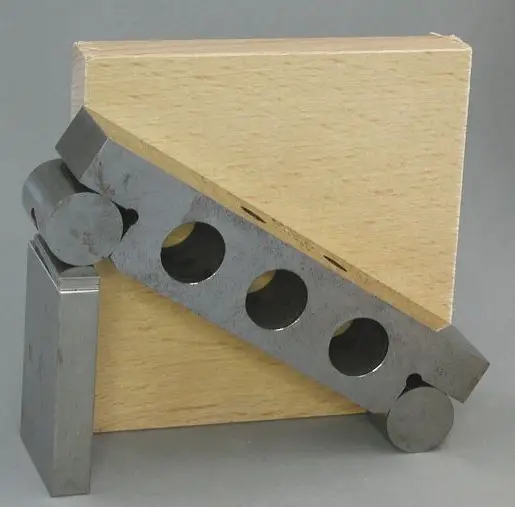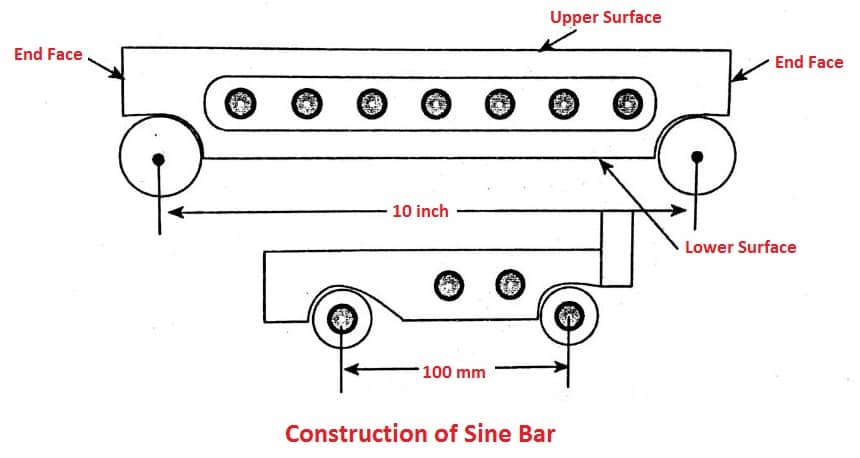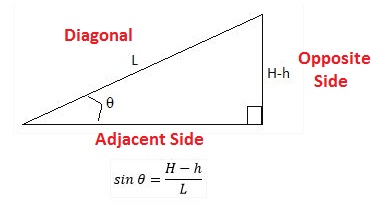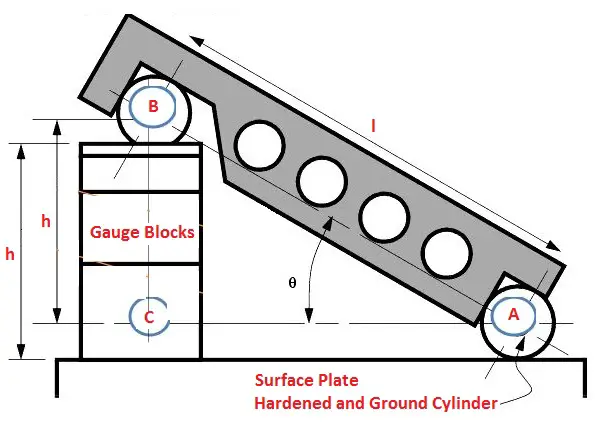In this post, you learn about the sine bar and its working principle, it’s construction, formula, reading, applications and more.
Sine Bar
A sine bar is a device used to measure angles in metals. It consists of a hardened ground body with two precision ground cylinders attached at the ends. The distance between the centres of the cylinders is accurately controlled, the top of the bar is parallel to a line through the centres of the two rollers.

The dimension between the two rollers is chosen to be an entire number (for ease of subsequent calculation) and forms the hypotenuse of a triangle when in use. The figure shows a 10 inch and a 100 mm sine bar.
Read also:
- What are the different types of Bevel Protractor?
- Mechanical Comparator: Types, Design, Working, Advantages
- What are the Errors in Vernier Caliper?
Working Principle of Sine bar
Angles are measured using a sine bar with the help of a gauge block and dial gauge or spirit level. The aim of a measurement is to make the surface on which the dial gauge or spirit level is placed horizontally.
For example, The wedge is placed on a horizontal table, to measure the angle of a wedge,
The sine bar is placed on the inclined surface of the wedge. In this case, the top surface of the sine bar is tilted like a wedge. The top surface is made horizontal by using gauge blocks.
The sine of an angle of inclination of the wedge is a ratio of the height of gauge blocks used and the distance between the centres of the cylinders.
When a sine bar is located on a level surface the top edge will be parallel to that surface. If one roller is raised by a known distance, usually using gauge blocks, then the top edge of the bar will be titled by the same amount forming an angle that calculated by the application of a sine rule.
- The hypotenuse is a constant dimension – (10 inches or 100 mm as the examples shown).
- The height is achieved from the dimension between the bottom of one roller and the table surface.
- The angle is measured by using a sine rule. The dimension required to obtain an angle from 0°-90°, incremented by 1-min intervals. Sine(angle) = opposite/hypotenuse.
- Angles can be measured or set with this tool.
Construction of Sine Bar
The sine bar is made of high carbon steel, high chromium (corrosion resistance) and hardened. It consists of two rollers with steel bars. The two rollers are very precise and highly accurate and are equal in diameter.

When the sine bar placed on a flat surface, the axes of the two rollers are parallel to each other and also parallel to the above face of the sine bar. The steel bar has the appearance of relief holes. (To easily handle the sine bar and also to reduce overall weight.
The distance between two rollers is usually available in 100 mm, 200 mm or 300 mm. There are two grades in the sine bar. A grade and B grade. A grade sine bar has an accuracy of 0.01mm /m length, B grade sine bar has an accuracy of 0.02mm /m length.
Sine Bar Formula and Reading
The sine bar is based on trigonometry.

- Sine θ = Opposite/Diagonal
- Cos θ = Adjacent/Opposite
- Tan θ = Opposite/Adjacent

The one roller is placed on a surface plate and the other is placed at height h by a slip gauge. The distance between the two setting rollers of the Sine Bar is given by L.
The above trigonometric formula Sine above = opposite/diagonal = h / L
From this we can write θ = sin^-1 (h / L).
This is the formula for sine bar for calculating the angle or setting the workpiece to the required angle. This device is called “Sine Bar”.
Limitations
Following are the limitations of sine bar:
- Any unknown projections present in the component will cause errors in the measured angle to be induced.
- For the construction of slip gauges, there is no scientific approach available and it has to be built on trial and error basis and it is a time-consuming process.
- During the measurement of the angle using the sine bar, the sine bar length must be greater than or equal to the length of the component to be inspected.
- If the length of the inspected component is too long, there is no sine bar available that is longer than the component. In these cases, the sine bar will be used together with the height gauge for measurement.
Applications
Following are the applications of sine bar:
- The sine-bar is used to set or determine the workpiece at a given angle.
- For checking the measurement of unknown angles in the workpiece.
- Some specially designed sine bars are used to mount the workpiece to perform conical-shaped machining for the workpiece.
- To check for unknown angles on heavy components.
- For checking the angles of taper key.
- To check the flatness of the surface.
Conclusion
So now, we hope that we have clear all your doubts about Sine Bar. If you have still any doubts about “Working of Sine Bar” you can contact us or ask in the comments.
That’s it thanks for reading. If you like our article then please share it with your friends. If you have any questions about any topic you can ask in the comment section.
Subscribe to our newsletter to get notification of our new posts.
Read Next: